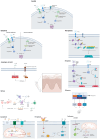How Cells Die in Psoriasis?
- PMID: 40332377
- PMCID: PMC12027842
- DOI: 10.3390/ijms26083747
How Cells Die in Psoriasis?
Abstract
Psoriasis, a chronic immune-mediated inflammatory skin disorder characterized by keratinocyte hyperproliferation and inflammatory cell infiltration, involves multiple distinct programmed cell death pathways in its pathogenesis. Following the Nomenclature Committee on Cell Death recommendations, we analyzed the current literature examining diverse modes of cellular death in psoriatic lesions, with particular focus on keratinocyte cell death patterns and their molecular signatures. Analysis revealed several distinct cell death mechanisms: autophagy dysfunction through IL-17A pathways, decreased apoptotic activity in lesional skin, medication targeting anoikis in psoriasis, upregulated necroptosis mediated by RIPK1/MLKL signaling, gasdermin-mediated pyroptosis with enhanced IL-1β secretion, coordinated PANoptotic activation through specialized complexes, PARP1-mediated parthanatos promoting cutaneous inflammation, iron-dependent ferroptosis correlating with Th22/Th17 responses, copper-dependent cuproptosis with elevated MTF1/ATP7B/SLC31A1 expression, and NETosis amplifying immune responses through interaction with the Th17 axis. The intricate interplay between these cell death mechanisms has led to the development of targeted therapeutic strategies, including mTOR inhibitors for autophagy modulation, RIPK1 inhibitors for necroptosis, and various approaches targeting ferroptosis and NETosis, providing new directions for more effective psoriasis treatments.
Keywords: cell death; prospective therapeutic approaches; psoriasis.
Conflict of interest statement
Tsen-Fang Tsai has served as a consultant for Abbvie, AnaptysBio, Boehringer Ingelheim, Bristol-Myers Squibb, Celgene, Eli-Lilly, Galderma, GSK, Janssen-Cilag, Leo Pharma, Merck Sharp and Dohme, Novartis International, Pfizer, PharmaEssentia, Sanofi, Sun Pharma and UCB Pharma. The other authors have no conflicts of interest to declare.
Figures
References
Publication types
MeSH terms
LinkOut - more resources
Full Text Sources
Medical
Research Materials
Miscellaneous


